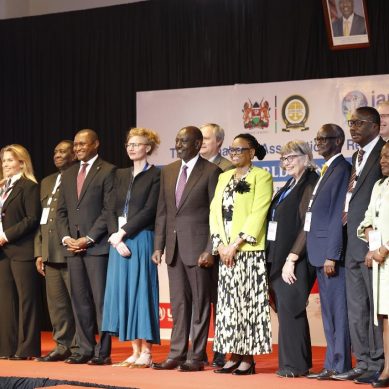
Despite fairly strong economic growth, especially after a major global Covid-19 pandemic, most Americans weren’t feeling like they were getting ahead economically.
After securing the nomination, Democrat Kamala Harris initially put many of those concerns to rest. Harris revitalised a beleaguered Democratic campaign, attracting record-high funding and a groundswell of support. She soon moved ahead of Republican’s Donald Trump in the polls, a sign she was sparking enthusiasm among voters, particularly among women. Trump had previously been seen as the frontrunner, partly based on his perceived strength on the economy after several years of high inflation under Biden.
She aced her first big test – a September 10 televised debate against Trump.
As Harris’s team prepared for what would be her only in-person face-off with Trump, they focused on ways to unnerve the former president and draw attention to his frequent falsehoods on policies, according to several aides involved in the preparations. Harris holed up in Pittsburgh with advisers and conducted mock debates for the prime-time showdown, the aides said.
The strategy paid off. Harris appeared to get under her rival’s skin during the debate. She pressed Trump on the economy, Ukraine, healthcare, the January 2021 Capitol riots and abortion, leaving him rattled and struggling to respond.
Fundraising spiked: Her campaign said it raised $47 million in the 24 hours after the debate. Most voters thought Harris had won, polls showed. Trump shot down offers for another debate, claiming he’d already beaten her.
On the campaign trail, Harris mocked Trump’s debate performance, including his comment that he had “concepts of a plan” to replace a federal health care law. As she gained in polls, Harris’ campaign believed she was opening up states that had been out of reach for Biden, including North Carolina, where the president had his narrowest loss against Trump in 2020 and where she was drawing even in the polls with Trump.
North Carolina was the scene of her next big test, the late September Hurricane Helene, one of the deadliest storms to hit the US in the last 50 years. The storm shifted focus from messages at the foundation of Harris’ campaign to the handling of the disaster by the Biden-Harris administration.
It hit just as her lead was narrowing. Trump went on the attack, criticising the Democratic administration’s response to the disaster and tying it to his strongest issue, immigration. As the death toll rose and swathes of North Carolina lay devastated, Trump amplified and spread falsehoods, including a claim that Harris spent disaster-assistance money on housing illegal migrants.
In response to a recent request for comment about false claims about how disaster funds were being used, the Trump campaign repeated accusations that money had been spent on housing migrants in the country illegally.
Harris cut short a campaign swing and flew to Washington on September 30 for a briefing on Biden’s emergency response. On her plane, three staffers sat on the floor, ripping apart briefing books, replacing the pages with new notes, a reporter witnessed.
The disaster, which killed more than 200 people, marked a shift in the race, as misinformation around the administration’s response and Trump’s hardline rhetoric on immigration gained traction. The baseless claims included that the government covered-up deaths, confiscated charitable donations and diverted disaster funds to help immigrants. Harris’ campaign struggled to address both the false claims and voters’ concerns about an uptick in illegal border crossings during Biden’s presidency.
One jurisdiction that illustrated the risks for Harris was Buncombe County, a North Carolina Democratic stronghold of about 280,000 people hammered by the storm. In its aftermath, Democrats stopped targeting potentially persuadable Republican voters there because of concerns they had become too hostile amid the misinformation, Kathie Kline, Buncombe County Democratic chair, said. In the end, Trump won the state.
As the race tightened through October, and polls indicated a toss-up, alarm spread among Democratic strategists.
They focused on shoring up the so-called Blue Wall of Democratic states: Michigan, Pennsylvania and Wisconsin. Eight years ago, when Trump beat Hillary Clinton, he breached the Blue Wall by winning all three states, each by less than a percentage point. In 2020, Biden won them back. Holding the Blue Wall now was Harris’ best path to the White House, the strategists reasoned. But they had a problem: Michigan and the Gaza War.
Michigan’s large population of Arab Americans and Muslims helped cement Biden’s 2020 victory in the state. Trump turned off many of these voters in his first term, in part by banning immigration to the US from a number of Muslim countries early in his tenure.
In the race’s final stretch, Muslim and Arab-American voters said they were disappointed Harris did not distance herself more from Biden’s unwavering support of Israel during the Gaza war. In the final weeks, Trump aggressively courted their vote. Many said they would sit out the election or vote Republican.
Harris staffers knew that disillusioned Muslim and Arab-American Democrats were a risk. “It could cost us the election,” said a senior Michigan operative for Harris in July.
The campaign ultimately concluded it was impossible to fully win back those voters. To offset their loss, campaign officials said they focused in the final weeks on marshalling enough support from union workers and Black voters in Detroit, the nation’s largest Black-majority city.
But few issues threatened Harris like inflation. What about inflation?
Her campaign had hoped the economic recovery from the pandemic would be a winning issue. Growth is markedly more robust in the US than in other major industrial nations. Stock-market indexes are near record highs.
Instead, the issue eroded Democratic support throughout much of 2024 as union workers and non-college-educated white voters broke for Trump, polls showed. Sharp increases in housing and food costs frustrated voters, overshadowing a strong job market. Trump blamed Harris for the spike during her and Biden’s time in office.
While most unions have long supported Democratic candidates, rank-and-file workers in recent years have moved behind Trump, proving a decisive factor in his victory. There were some positive signs for Harris. The AFL-CIO, the largest federation of unions, saw a surge in female members supporting Harris and willing to volunteer for her, AFL-CIO President Liz Shuler said.
In the final weeks of the race, Harris’ momentum appeared to have stalled, with polls showing her edge over Trump narrowing. By mid-October, the race was a dead heat in crucial states.
A pronounced gap in polling between men and women had emerged, too. While Harris cut away at the Republicans’ longstanding edge with white voters overall by gaining ground with white women, Trump appeared to be boosting his advantage with men.
Harris shifted strategy in an attempt to win over more men and Republicans. The campaign dispatched running mate Walz on a tour in mid-October to reach male voters. Harris also held campaign events with former lawmaker Liz Cheney, one of Trump’s fiercest Republican critics and one of the most prominent conservatives to endorse the Democrat. Days later, Trump suggested Cheney should face gunfire in combat, drawing outrage among Democrats and pundits.
The vice president also sharpened her attacks on Trump. In an October 29 speech billed as her closing argument, Harris warned of the dangers of another Trump presidency. He was “unstable” and sought “unchecked power,” she told a rally held at the spot in Washington where Trump addressed his supporters before they attacked the US Capitol on January 6, 2021. With a well-lit White House behind her, she cast herself as a defender of democracy, unity and freedom.
She also sought to reassure voters about the cost of living. Trump’s proposals to raise tariffs would amount to “a 20 per cent national sales tax” on imported goods, she said. She vowed to “protect hard-working Americans who aren’t always seen or heard.”
In the end, not enough of those Americans believed her.
- A Reuters report








